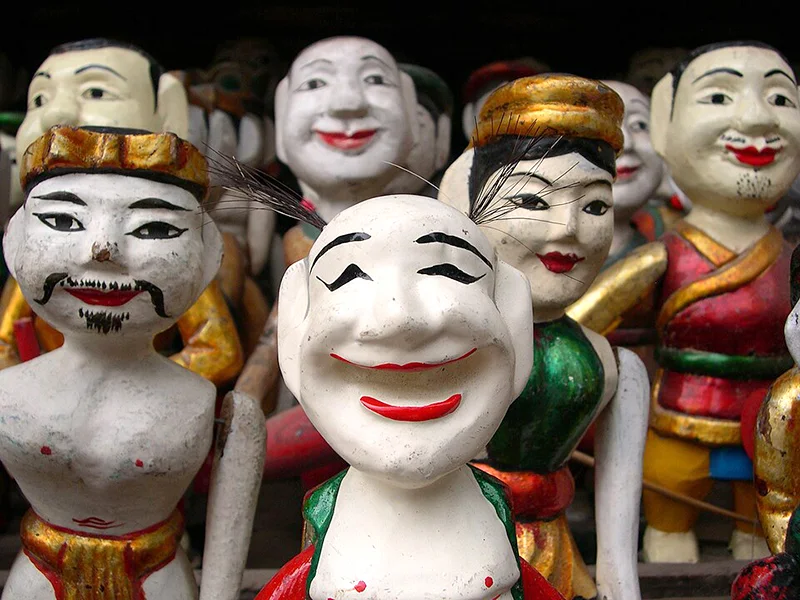Water puppetry, known as "múa rối nước" in Vietnamese, is a unique and ancient form of folk theater originating in the northern villages of Vietnam. It is a captivating art that combines puppetry with a water stage, bringing Vietnamese legends, folklore, and rural life scenes to life in a way that is as enchanting as it is deeply cultural.
1. Origins and History
Water puppetry dates back to the 11th century, believed to have originated in the Red River Delta in northern Vietnam. Farmers who lived in flooded rice paddies began using water as the stage for their wooden puppets, which led to the creation of this distinct form of theater. This tradition was initially part of village celebrations and festivals, performed in natural ponds, lakes, or specially designed water pools.
The art form was closely tied to the communal life of rural villages, where people gathered to celebrate the end of the harvest season or to honor deities. Over time, it evolved, but the themes and techniques remain similar to those used centuries ago.
2. The Art and Mechanics of Water Puppetry
Water puppetry requires skill and expertise, as puppeteers operate intricate wooden puppets from behind a screen, using long bamboo rods and strings under the water to control them. The water not only hides the puppeteers but also adds an element of mystique, allowing puppets to appear as if they are floating, diving, or gliding over the surface.
- The Water Stage: Traditionally, water puppetry is performed in a waist-deep pool of water, with a curtained screen hiding the puppeteers. The water surface adds dramatic effects, helping create the illusion of swimming fish, splashing water, and even mythical creatures like dragons.
- The Puppets: Puppets are typically made of wood and are brightly painted to depict characters such as villagers, animals, and mythical creatures. They can weigh up to 15 kilograms (33 pounds), making them challenging to manipulate.
- Puppeteers: Skilled puppeteers stand behind a bamboo screen, partially submerged, moving the puppets with rods and strings. They train extensively to synchronize movements, bringing each character to life with precision.

|
| Img: Wikipedia |

|
| Img: Dan Lundberg |

|
| Img: Daniel Mennerich |

|
| Img: Dan Lundberg |
3. Themes and Stories
Water puppet performances are rooted in Vietnamese folklore, often revolving around themes of rural life, mythology, and cultural values. Popular scenes include legends of the founding of Vietnam, humorous tales of village life, and agricultural scenes that reflect the rice-growing lifestyle of Vietnamese peasants.
Some classic characters and motifs in water puppetry include:
- Chú Tễu: The mischievous “Uncle Tễu” serves as the narrator and comic relief, often opening the show with jokes and commentary.
- Mythical Creatures: Dragons, phoenixes, and unicorns symbolize Vietnamese folklore and appear in many scenes, often during festivals and celebrations.
- Everyday Life: Scenes depicting farmers planting rice, fishermen casting nets, and families celebrating festivals give audiences a glimpse of traditional Vietnamese rural life.

Uncle Tễu (Source Wiki)

|
| Img: Mor |

|
| Img: Flickr |
4. Traditional Music and Sound Effects
Live music plays a central role in water puppetry, enhancing the drama and emotion of each scene. Musicians, typically located on either side of the stage, perform traditional Vietnamese music using instruments such as bamboo flutes, drums, cymbals, and gongs. Vocalists provide narration, sing folk songs, and create sound effects that match the movements of the puppets, adding rhythm and depth to the performance.

|
| Img: Daniel Mennerich |
5. Notable places to see water puppetry in Vietnam
- Thang Long Water Puppet Theatre in Hanoi: 57B Đinh Tiên Hoàng St., Hoàn Kiếm District, Hanoi
- Hoi An Theatre in Hoi An, where shows are smaller but offer an intimate experience.
- Hue Water Puppet Theatre in Hue: 8 Lê Lợi St., Vĩnh Ninh District, Hue
- Golden Dragon Water Puppet Theatre : 55B Nguyễn Thị Minh Khai St., District 1, HCMC.
Conclusion
Vietnamese water puppetry stands out as one of the most unique and enduring traditional arts. With its blend of storytelling, music, and skillful manipulation, it offers audiences a window into Vietnam’s folklore and rural life, keeping the spirit of Vietnam's cultural history alive and resonant in the modern era.